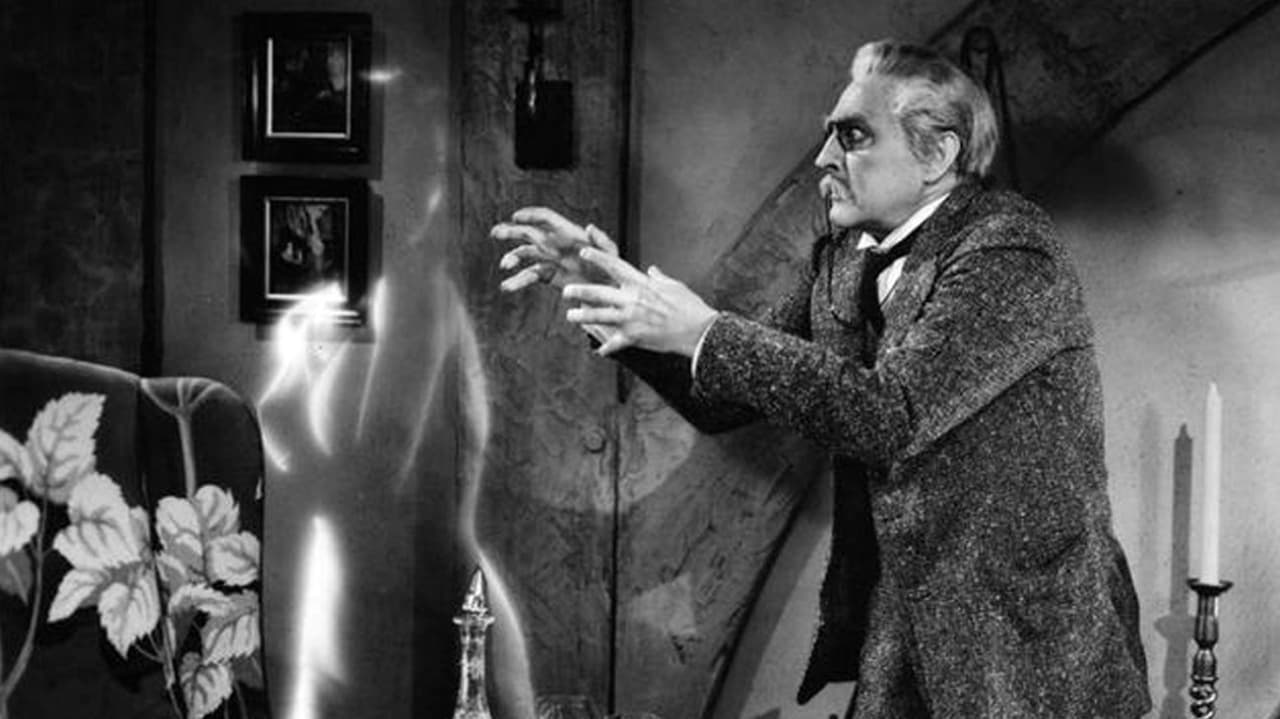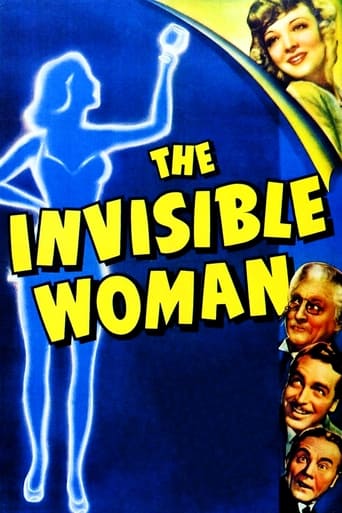

While it doesn't offer any answers, it both thrills and makes you think.
... View MoreGreat story, amazing characters, superb action, enthralling cinematography. Yes, this is something I am glad I spent money on.
... View MoreA terrific literary drama and character piece that shows how the process of creating art can be seen differently by those doing it and those looking at it from the outside.
... View MoreThere is, somehow, an interesting story here, as well as some good acting. There are also some good scenes
... View MoreA scientist (a sadly aged John Barrymore) invents a machine that can turn people invisible. He experiments on a young woman (Virginia Bruce) and it works. However the effect wears off after a while. Then some buffoonish gangsters get involved and the movie becomes unbearable.Squarely aimed at kids and full of violent unfunny slapstick. The cast (which also includes John Howard and Margaret Hamilton) are good but the material isn't there for them. The special effects are good but sparsely used (the film is only 70 minutes). The biggest problem in this film is seeing the great John Barrymore looking terrible in what was one of his last film roles. The role is clearly beneath him but he gives it his all. Still this is an unfunny and violent comedy that is forgettabke. Skip it.
... View MoreDelightful comedy from start to finish, with plenty of bounce and throw-away lines. Of course, invisible people can be the stuff of horror, but there's plenty of shtick in the idea, as well. For example, the Topper series (1953-55) made good comedic appeal in TV's early days, while Abbott and Costello spoofed the idea in maybe their best " A&C Meet__" (1951).Here, it's a first-rate cast, including some of Hollywood's most colorful lugs— including, Ed Brophy, Donald McBride, Shemp Howard, and mugging it up comedically, John Barrymore. Seems Barrymore's invented a fade-away gizmo that he wants patented, but first has to get seed money from playboy John Howard. Then too he needs to hire a human guinea pig to prove that the gizmo works, and that's dress-model Virginia Bruce who's out for revenge against her cruel boss (Lane). Naturally crooks get wind of the invention and want to hijack it. So, amusing mayhem ensues.Note the lengths the script manages to avoid that awful word "naked". Instead a number of Code euphemisms are employed. Still, the shtick makes funny use of Bruce's being naked when invisible. In fact, the writers go to some lengths making her occasional lack of clothes realistic— e.g. she gets cold up at the cabin. Anyway, the well-timed gags fly thick and fast, along with expert pacing from director Sutherland. At the same time, Charlie Ruggles almost steals the show as the impeccable butler. All in all, this Universal production amounts to a genuine sleeper despite the darkish title, and definitely deserves more frequent revival.
... View MoreIn the original "Invisible Man" feature of 1933, a biochemist named Jack Griffin had gone homicidally mad after injecting himself with his newly devised invisibility serum, leading to his death at the hands of the British police. Featuring Claude Rains in his first screen role, it was a very serious film, with a bare minimum of humor. In 1940, Universal came out with its belated sequel, perhaps inevitably entitled "The Invisible Man Returns." This film featured Vincent Price in his first horror role and was a marvelous follow-up, with only slightly more comedic content. Three more sequels would follow, and in the next, the series took an abrupt swerve into full-fledged, out-and-out comedy, and with very pleasing results. "The Invisible Woman" was released on 12/27/40, although most sources cite the film as being a product of 1941. Featuring a first-rate cast, excellent special FX and a laff-out-loud script, the film is a true delight, and a perfect watch for both adults and the kiddies alike.In the film, John Barrymore, in one of his last roles, plays the part of absentminded, acerbic Professor Gibbs, who has come up with a serum and a device that, when used in conjunction, will induce invisibility in the subject. Family friend, patron and millionaire playboy Dick Russell (John Howard) has no more money to support the professor's experiments, so Gibbs advertises in the paper for a person who will be willing to be a test subject for free. The ad brings in a beautiful blonde dress model named Kitty Carroll (Virginia Bruce), who thirsts for adventure and wants to turn invisible so that she might more easily take vengeance on Mr. Growley, her horrible boss. (In a moment that should surely touch an empathic chord with all modern-day commuters and wage slaves, Kitty proclaims, "Get up in the morning, run for the subway, punch the clock...run for the subway and go to bed. Docked when we're sick, when we're late. Treated like dogs, humiliated....") Gibbs' experiment, of course, is a complete success, as is Kitty's later campaign to take vengeance on Growley. But trouble looms when a gang of crooks decides that the professor's new gizmo might be better off in their own hands....Those viewers who have seen John Barrymore in such marvelous screwball comedies as "Twentieth Century" (1934) and "Midnight" (1939) will not be surprised to learn how good the great dramatic actor is in this zany film. Barrymore throws himself into the role with zest, and despite being somewhat dissipated at this point, still looks quite handsome, the "Great Profile" still evident behind a bushy mustache. His hilarious line regarding alcohol's tendency to enhance his serum--"When you dissipate, you disappear"--only becomes more somber when one reflects on the actor's own drinking problem, and the fact that he would pass on just two years later. In the lead role, Bruce--who I had previously only seen in just two films, the grisly pre-Code stunner "Kongo" (1932) and the Abbott & Costello vehicle "Pardon My Sarong" (1942)--is absolutely adorable...when we can see her, that is, which, in this film, is rarely. A former Ziegfeld girl and wife of screen idol John Gilbert, she is quite winning here; no wonder playboy Dick falls in love with her, sight unseen. And as Dick Russell, John Howard--who many might recall from the long-running Bulldog Drummond film series, and others from his role in the Fox horror film "The Undying Monster" (1942)--is both likable and amusing. But just check out the rest of this amazing cast! We have the great Charles Ruggles (UNmustachioed here, for a change) as Dick's long-suffering butler; Margaret Hamilton, a year after getting "liquidated" in Oz, as Gibbs' long-suffering housekeeper; Austrian actor Oskar Homolka as Blackie, the hilarious head crook; the great character actor Edward Brophy as one of his henchmen (just one of a half dozen or so screen roles for Brophy that year!); future Stooge "Shemp" Howard as Frankie, another henchman; Charles Lane (whose filmography might be one of the longest in existence) as the growling Growley; and, playing one of Kitty's fellow dress models, the Cobra Woman herself, Maria Montez! "The Invisible Woman" has been directed with zippy panache by A. Edward Sutherland, who had himself been responsible for another grisly pre-Code shocker, "Murders in the Zoo" (1933). The film's FX, by John P. Fulton, hold up even in today's CGI filmscape--I particularly enjoyed the sight of Kitty's headless dress modeling--and the professor's invisibility machine, with its banks of blinking lights and zigzagging electrical arcs, might fit well into Frankenstein's laboratory. DOP Elwood Bredell has lensed the whole thing in gorgeous B&W, and really, the whole little film--it clocks in at a scant 72 minutes--is just charming and amusing from beginning to end; as the saying goes, they sure don't make 'em like this anymore! The invisible character in this film might not go as bonkers as the leads in the two previous pictures, but she sure does get to cut loose! And, oh...Virginia Bruce is necessarily bare naked throughout much of this film!!! Too bad, of course, that she just happens to be invisible at the time....
... View MoreVirginia Bruce is "The Invisible Woman" in this 1940 comedy that has nothing to do with the classic "The Invisible Man." The sad part for me is seeing John Barrymore, one of the greatest actors who ever lived, in a character role in this B+ film (budgeted at a whopping $300,000, a great deal more than usual B movies), even though he was excellent and the film is very enjoyable.Bruce plays Kitty Carroll, a department store model. She and the other models at the store are badly treated by their boss (Charles Lane) -- if they come in two minutes late, they're docked an hour, if they're sick, they're fired - he's a beast.John Barrymore is Professor Gibbs, a scientist who has invented a machine that will render people invisible. His patron, the wealthy Robert Russell (John Howard) is now broke thanks to all the lawsuits he's lost to girlfriends, and tells Gibbs that he can no longer support him. Gibbs desperately needs to make a human person invisible so he can patent his machine and both he and Russell can make some money. He advertises and gets Kitty, who has a particular agenda in mind.The Bruce role was intended for Margaret Sullavan, who refused to do it. Bruce is delightful, but with her in the lead, one thinks this was intended as a B movie when it wasn't at all. There are some wonderful characters on board, some of whom play gangsters trying to get their hands on this all-important machine: Oskar Homolka, Charles Ruggles, Shemp Howard, and Maria Montez. Margaret Hamilton is on hand as the Russell maid.What can I say about John Barrymore, except the man was adept at both drama and comedy and adds a great deal to this movie.Entertaining.
... View More